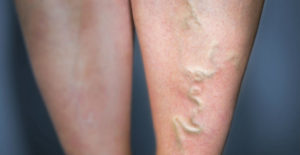 If the tissues within the skin are swollen or inflamed for a long period of time, it may cause Lipodermatosclerosis, which is an inflammation of the subcutaneous fat. This usually occurs due to venous insufficiency, which is what varicose veins cause due to insufficient blood flow through the veins. The legs may feel sore and swollen and the tissue will feel hard around the leg. This can cause many other conditions such as edema.
If the tissues within the skin are swollen or inflamed for a long period of time, it may cause Lipodermatosclerosis, which is an inflammation of the subcutaneous fat. This usually occurs due to venous insufficiency, which is what varicose veins cause due to insufficient blood flow through the veins. The legs may feel sore and swollen and the tissue will feel hard around the leg. This can cause many other conditions such as edema.
Deep Vein Thrombosis (DVT)
This is the most severe condition caused by varicose veins, hence why they should be treated. Many patients complaining of a “pulling sensation” in their leg and this is caused by a blood clot due to the build-up of blood in the vein. If this blood clot travels up further in the body, especially to the heart, lungs or brain, it can cause life-threatening injuries, as insufficient oxygen is delivered.
Hyperpigmentation
 When varicose veins are left untreated for a long period of time, it can cause excess blood to leak into the tissues of the affected area. This will cause painful inflammation and swelling of the tissue and the skin can become discolored and dark. Once hyperpigmentation occurs on the skin, it can be hard to get rid of. Although usually medically harmless to the body, it can cause body confidence issues for many people.
When varicose veins are left untreated for a long period of time, it can cause excess blood to leak into the tissues of the affected area. This will cause painful inflammation and swelling of the tissue and the skin can become discolored and dark. Once hyperpigmentation occurs on the skin, it can be hard to get rid of. Although usually medically harmless to the body, it can cause body confidence issues for many people.
Superficial Thrombophlebitis
Superficial Thrombophlebitis is another inflammatory condition caused by a blood clot in the veins beneath the skin. This affects the vein more than the surface of the skin, although the skin may become red around the affected area. The vein may feel very sensitive to touch, which can cause ongoing discomfort. Left untreated, this can cause other complications such as cellulitis, which is a skin infection caused by bacteria.
 Leaving varicose veins untreated can cause many other problems within the veins and surrounding tissues. Many problems that occur are very similar and it can be hard to know which one you are suffering from.
Leaving varicose veins untreated can cause many other problems within the veins and surrounding tissues. Many problems that occur are very similar and it can be hard to know which one you are suffering from.


